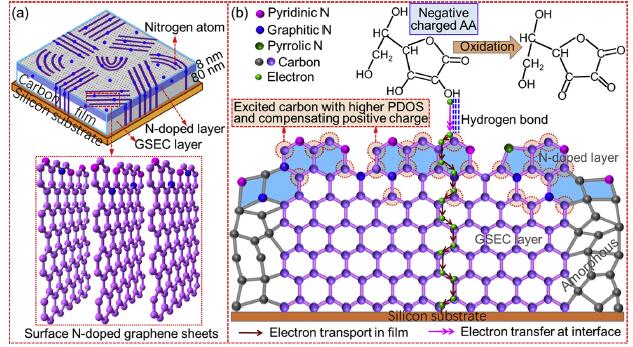Surface N-doped graphene sheets induced high electrocatalytic activity for selective ascorbic acid sensingViews [1634] Delivery time :2018-12-24 10:42:26
Surface N-doped graphene sheets induced high electrocatalytic activity for selective ascorbic acid sensing
Sensors & Actuators: B. Chemical 283 (2019) 556–562 (PDF-File)
Liangliang Huang , Yuanyuan Cao* , Dongfeng Diao*
In this study, the graphene sheets embedded carbon (GSEC) film was modified with surface N-doping for highly selective  ascorbic acid (AA) sensing. We found that the N-doped graphene sheets formed in-situ at the carbon film surface and induced high electrocatalytic activity for AA oxidation. Although surface N-doping slightly decreased the ID/IG and surface roughness of carbon film, the graphene sheets embedded in amorphous were preserved. With surface N-doping, the charge-transfer resistance was reduced from 22.5 Ω cm2 to 3.9 Ω cm2, the oxidation-reduction peak separation decreased to a low value of 65.7 mV in Fe(CN)6 4−/3− redox system, and the standard rate constant was increased from 0.24×10-2 to 1.36×10-2 cm·s-1. The surface N-doped graphene sheets embedded carbon (SN-GSEC) decreased the oxidation potential of AA from 0.186 V to 0.025 V (vs. Ag/AgCl) and realized selective detecting of AA. The mechanism may be that the surface N-doping induce the adjacent carbon in graphene sheets to obtain a higher partial density of states and more positive compensating charge. This study provides a simple method for preparing high performance electrochemical biosensor.
ascorbic acid (AA) sensing. We found that the N-doped graphene sheets formed in-situ at the carbon film surface and induced high electrocatalytic activity for AA oxidation. Although surface N-doping slightly decreased the ID/IG and surface roughness of carbon film, the graphene sheets embedded in amorphous were preserved. With surface N-doping, the charge-transfer resistance was reduced from 22.5 Ω cm2 to 3.9 Ω cm2, the oxidation-reduction peak separation decreased to a low value of 65.7 mV in Fe(CN)6 4−/3− redox system, and the standard rate constant was increased from 0.24×10-2 to 1.36×10-2 cm·s-1. The surface N-doped graphene sheets embedded carbon (SN-GSEC) decreased the oxidation potential of AA from 0.186 V to 0.025 V (vs. Ag/AgCl) and realized selective detecting of AA. The mechanism may be that the surface N-doping induce the adjacent carbon in graphene sheets to obtain a higher partial density of states and more positive compensating charge. This study provides a simple method for preparing high performance electrochemical biosensor.
